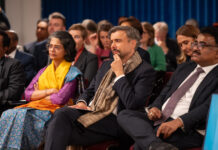The recently published report by the United Nations Food and Agricultural Organization (FAO) based in Rome Illuminating Hidden Harvests is subtitled – Illuminating Hidden Harvests. Launched on 16 March 2023, at a hybrid webinar in Rome, the report is an important milestone and major output of a global joint initiative by the three institutions to generate and disseminate new evidence about the importance of small-scale fisheries to inform policy and practice.
Over 800 authors and experts worldwide contributed to the 325-page report, which assesses the contributions of small-scale fisheries to sustainable development, and the environmental, economic, gender, food security and nutrition, and governance dimensions of small-scale fisheries globally. The findings, recommendations, research, and voluntary guidelines for small-scale fisheries stakeholders in government, and small-scale fisheries organizations can transform understanding of national small-scale fisheries and contribute to improvements in policy, legislation, statistics, and monitoring as well as targeted support and recognition of small-scale fisheries. Various data sets and studies from 55 to 90 countries are reflected in the project that also reflects the improving quality of data around the world.
While the report is complex and fascinating, it is emphatic that the contributions of small-scale fishing have been underestimated in terms of its economic scale, its contribution to nutrition, and the employment that it offers especially to women and hence to gender equality. Small-scale fishing makes up 40% or 37 million tons of the annual global fishing catch of 92 million tons. The large-scale fisheries using larger motorized boats, trawlers, weighted gill nets from 300 feet to 7 miles in length, and other industrial methods – make up the remaining 60% of the global fish catch annually.
 While the small-scale fishery sector employs 90% of those in global fishing, the large-scale fishing industry which 55 produces million tons of the annual 92 million ton catch, employs only 10% of those engaged in this universal and ancient human activity. However, although small-scale fishing produces only 40% of the catch it generates a better economic value – 44% in the countries studied. This may be because, unlike industrial or organized fishing, the catch is locally consumed or closer to its market. These simpler supply chains are based on reaching the fresh catch to customers without industrial food processing or elaborate cold chains.
While the small-scale fishery sector employs 90% of those in global fishing, the large-scale fishing industry which 55 produces million tons of the annual 92 million ton catch, employs only 10% of those engaged in this universal and ancient human activity. However, although small-scale fishing produces only 40% of the catch it generates a better economic value – 44% in the countries studied. This may be because, unlike industrial or organized fishing, the catch is locally consumed or closer to its market. These simpler supply chains are based on reaching the fresh catch to customers without industrial food processing or elaborate cold chains.
The multidisciplinary report has used several new methods to re-examine the previous data sets concerning small-scale fishing to come to its findings that a surprising 60.2 million people are directly employed full or part-time in small-scale fishing while another 492 million depend at least partially on it for employment. The study has discovered that 4 in 10 people engaged in small-scale fishing are women.

Most of those fully or part-time employed in small-scale fishing live in ten countries of which the leading five are in Asia. China leads in employment in this sector at 35.5 million, India is second at 13.1 million, Bangladesh at 12.9 million, Indonesia at 4.7 million, and Pakistan at 4.4 million.
The small-scale fishery sector is low-tech, low-cost representing, self-employed or community-level coastal, riverine, or inland cultivation – although the report suggests that fishing is a continuum often difficult to segment in terms of organization, capital, or equipment employed or scale. The overall annual fishery catch globally was US$ 77.2 billion from 2013 to 2017– a revision in economic value that is 49% higher than the earlier 2012 study.
The key findings at first glance seem to be the previously underestimated scale of the industry and its contribution to the economy in terms of value, employment, and as a source of nutrition. It notes that fish landings could provide 20% of the daily nutrition requirements of calcium, selenium, and zinc to 137 million women in Africa and 271 women in Asia.

The impact on livelihoods of what are sometimes considered marginal coastal populations is remarkable as is the 40% employment of women in the sector. The report estimates 113 million people were employed in catching and processing in the value chain or for their subsistence in 2016. It suggests that together with their families and communities more than half a billion of the global population may be supported by this sector.
There are many insights in the report for exploration, validation, and update of the data since the report is presented as a correction of previous data sets. The granularity of multidisciplinary insights into the dietary, economic, and social value of the small-scale fishing sector requires serious reflection by government agencies.
The self-organizing aspect of marginal and coastal communities and the role of women are especially interesting. It must also be kept in mind that this sector will face threats from global warming, the pollution of the rivers and seas by plastic and other harmful substances as well as encroachment of territorial waters and fishing limits by large-scale and mechanized fishing.
IndiFoodBev — authentic, impactful and influential
An English-language food and beverage processing and packaging industry B2B platform in print and web, IndiFoodBev is in its third year of publication. It is said that the Indian food and beverage industries represent approximately US$ 900 billion in revenues which implies more than 20% of the country’s GDP. Eliminating the wastage on the farmside can help to deliver more protein to a higher number of the population apart from generating sizable exports. The savings in soil, seeds, water, fertilizer, energy and ultimately food and nutrition could be the most immense contribution that country is poised to make to the moderation of climate change.
To improve your marketing and grow sales to the food and beverage processing and packaging industry, talk to us. Our research and consulting company IppStar [www.ippstar.org] can assess your potential and addressable markets in light of the competition. We can discuss marketing, communication, and sales strategies for market entry and growth.
Suppliers and service providers with a strategy and budget for targeted marketing can discuss using our hybrid print, web, video, and social media channels to create brand recognition linked to market relevance. Our technical writers are ready to meet you and your customers for content.
The second largest producer of fruit and vegetables in the world is continuously expanding processing capacities and delivery systems with appropriate innovative technologies. We cover product and consumer trends, nutrition, processing, research, equipment and packaging from farm to thali. Get our 2025 media kit and recalibrate your role in this dynamic market. Enhance your visibility and relevance to existing markets and turn potential customers into conversations. Ask for a sample copy of our bi-monthly in print or our weekly IndiFoodBev eZine each Wednesday.
For editorial info@ippgroup.in — for advertisement ads1@ippgroup.in and for subscriptions subscription@ippgroup.in
Naresh Khanna – 10 February 2025
Subscribe Now











